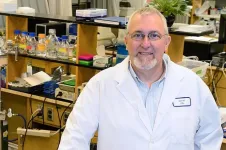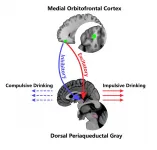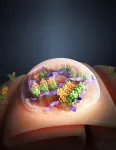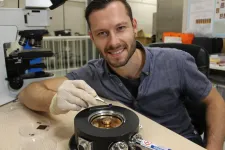Popular tool for measuring child feeding practices validated by RIT researcher
2021-02-08
(Press-News.org) A Rochester Institute of Technology researcher has validated a tool measuring adherence to a popular child feeding approach used by pediatricians, nutritionists, social workers and child psychologists to assess parents' feeding practices and prevent feeding problems.
The best-practice approach, known as the Satter Division of Responsibility in Feeding, has now been rigorously tested and peer reviewed, resulting in the quantifiable tool sDOR.2-6y. The questionnaire will become a standard parent survey for professionals and researchers working in the early childhood development field, predicts lead researcher Barbara Lohse, director of RIT's Wegmans School of Health and Nutrition.
"We've shown that the Satter survey can be used to measure that a child from 2 to 6 years old is at nutrition risk," Lohse said. "It's important to identify that early and prevent it from continuing because the last thing we want to have is a child at nutrition risk. They're not going to grow or develop correctly."
Pediatricians and other professionals working with young children require accurate tools to assess risk factors associated with a child's physical and emotional eating environment. The right questionnaire completed by a child's parent or guardian about childhood feeding and eating can lead to timely interventions.
Although many surveys about childhood feeding exist, until now, none have adequately measured the Satter division of responsibility in feeding, Lohse noted. "The theoretically grounded, research-supported approach is used in medical, public health, and in early childhood health-education venues."
Developed by Ellyn Satter, the method is associated with good parenting and positive eating behaviors and family dynamics. The Ellyn Satter Institute offers models for improving feeding dynamics and eating competence and is a resource for healthcare professionals, educators, and the public.
Satter's common-sense approach to childhood feeding and eating lacked the supporting evidence to explain why and how it worked. Lohse and Satter set out to rigorously test and validate the division of responsibility in feeding. They winnowed the survey down from 38 to 12 questions based on interviews with parents, video recorded parent-child interactions around feeding time, and compared it to other validated surveys to create the Satter Division of Responsibility in Feeding tool, the sDOR.2-6y.
"The key thing that is really important is that this 12-item survey was able to identify children at nutrition risk," Lohse said. "The Satter survey clearly correlated with other validated instruments on parent feeding that are much longer and much more in depth."
The survey also provides a view into areas of parent functioning such as sleep, stress, and parenting style, Lohse said. Her research shows that parents who follow the Satter Division of Responsibility tend to be more eating competent and exhibit other related factors. "They tend to have better sleep and less uncontrolled, emotional eating," Lohse said. "That was important to find out that the parents who practice this approach tend to have better habits themselves."
INFORMATION:
The authors' findings appear in the Journal of Nutrition Education and Behavior and the Journal of the Academy of Nutrition and Dietetics.
Their research was funded by the U.S. Department of Agriculture Food and Nutrition Services Supplemental Nutrition Assistance Program through an agreement with the Pennsylvania Department of Human Services, and Pennsylvania State University, and the Rochester Institute of Technology, Wegmans School of Health and Nutrition.
The sDOR.2-6y and scoring guidelines are available by contacting Barbara Lohse at balihst@rit.edu.
For more information, contact Susan Gawlowicz at 585-475-5061, susan.gawlowicz@rit.edu, or on Twitter: @SGawlowicz.
ELSE PRESS RELEASES FROM THIS DATE:
2021-02-08
Astronomers may have found our galaxy's first example of an unusual kind of stellar explosion. This discovery, made with NASA's Chandra X-ray Observatory, adds to the understanding of how some stars shatter and seed the universe with elements critical for life on Earth.
This intriguing object, located near the center of the Milky Way, is a supernova remnant called Sagittarius A East, or Sgr A East for short. Based on Chandra data, astronomers previously classified the object as the remains of a massive star that exploded as a supernova, one of many kinds of exploded stars that scientists have catalogued.
Using longer Chandra observations, a team of astronomers has now instead concluded that the object is left over from a different type of ...
2021-02-08
Findings from a new study on Alzheimer's disease (AD), led by researchers at the University of Saskatchewan (USask), could eventually help clinicians identify people at highest risk for developing the irreversible, progressive brain disorder and pave the way for treatments that slow or prevent its onset.
The research, published in the journal Scientific Reports in early January, has demonstrated that a shorter form of the protein peptide believed responsible for causing AD (beta-amyloid 42, or Aβ42) halts the damage-causing mechanism of ...
2021-02-08
A pathway in the brain where alcohol addiction first develops has been identified by a team of British and Chinese researchers in a new study
Could lead to more effective interventions when tackling compulsive and impulsive drinking
More than 3 million deaths every year are related to alcohol use globally, according to the World Health Organisation
The physical origin of alcohol addiction has been located in a network of the human brain that regulates our response to danger, according to a team of British and Chinese researchers, co-led by the University of Warwick, the University ...
2021-02-08
On a brisk November morning in 2018, a fire sparked in a remote stretch of canyon in Butte County, California, a region nestled against the western slopes of the Sierra Nevada mountains. Fueled by a sea of tinder created by drought, and propelled by powerful gusts, the flames grew and traveled rapidly. In less than 24 hours, the fire had swept through the town of Paradise and other communities, leaving a charred ruin in its wake.
The Camp Fire was the costliest disaster worldwide in 2018 and, having caused 85 deaths and destroyed more than 18,000 buildings, it became both the deadliest and most destructive wildfire ...
2021-02-08
An unusual biologically active porphyrin compound was isolated from seabed dweller Ophiura sarsii. The substance might be used as an affordable light-sensitive drug for innovative photodynamic therapy and for targeted treatment of triple-negative breast cancer and some other cancers. Researchers from the School of Biomedicine of Far Eastern Federal University (FEFU) and the University of Geneva reported the findings in Marine Drugs.
The seabed dweller Ophiura sarsii, the source of the new compound, was isolated at a depth of 15-18 meters in Bogdanovich Bay, Russky Island (Vladivostok, Russia). Ophiuras may resemble ...
2021-02-08
DALLAS - Feb. 8, 2021 - Pregnant women, who are at increased risk of preterm birth or pregnancy loss if they develop a severe case of COVID-19, need the best possible guidance on whether they should receive a COVID-19 vaccine, according to an article by two UT Southwestern obstetricians published today in JAMA. That guidance can take lessons from what is already known about other vaccines given during pregnancy.
In the Viewpoint article, Emily H. Adhikari, M.D., and Catherine Y. Spong, M.D., describe how the available safety and effectiveness data, basic science of mRNA vaccines, and long history ...
2021-02-08
DALLAS - Feb. 8, 2021 - A new nanoparticle-based drug can boost the body's innate immune system and make it more effective at fighting off tumors, researchers at UT Southwestern have shown. Their study, published in Nature Biomedical Engineering, is the first to successfully target the immune molecule STING with nanoparticles about one millionth the size of a soccer ball that can switch on/off immune activity in response to their physiological environment.
"Activating STING by these nanoparticles is like exerting perpetual pressure on the accelerator to ramp up the natural innate immune response to a tumor," says study leader Jinming Gao, Ph.D., a professor in UT Southwestern's Harold C. Simmons Comprehensive ...
2021-02-08
AURORA, Colo. (February 8, 2021) - Researchers from the Barbara Davis Center for Childhood Diabetes at the University of Colorado Anschutz Medical Campus have found that immune responses to insulin could help identify individuals most at risk for developing Type 1 diabetes.
The study, out recently in the Proceedings of the National Academy of Sciences, measured immune responses from individuals genetically predisposed to developing Type 1 diabetes (T1D) to naturally occurring insulin and hybrid insulin peptides. Since not all genetically predisposed individuals ...
2021-02-08
An international team of scientists has invented the equivalent of body armour for extremely fragile quantum systems, which will make them robust enough to be used as the basis for a new generation of low-energy electronics.
The scientists applied the armour by gently squashing droplets of liquid metal gallium onto the materials, coating them with gallium oxide.
Protection is crucial for thin materials such as graphene, which are only a single atom thick - essentially two-dimensional (2D) - and so are easily damaged by conventional layering technology, said Matthias Wurdack, who is the lead author of the group's publication in Advanced Materials.
"The protective coating ...
2021-02-08
A framework designed to provide detailed information on agricultural groundwater use in arid regions has been developed by KAUST researchers in collaboration with the Saudi Ministry of Environment Water and Agriculture (MEWA).
"Groundwater is a precious resource, but we don't pay for it to grow our food, we just pump it out," says Oliver López, who worked on the project with KAUST's Matthew McCabe and co-workers. "When something is free, we are less likely to keep track of it, but it is critical that we measure groundwater extraction because it impacts both food and water security, not just regionally, but globally."
Saudi Arabia's farmland is often irrigated via center pivots that tap underground aquifer sources. The team has built a powerful tool ...
LAST 30 PRESS RELEASES:
[Press-News.org] Popular tool for measuring child feeding practices validated by RIT researcher







